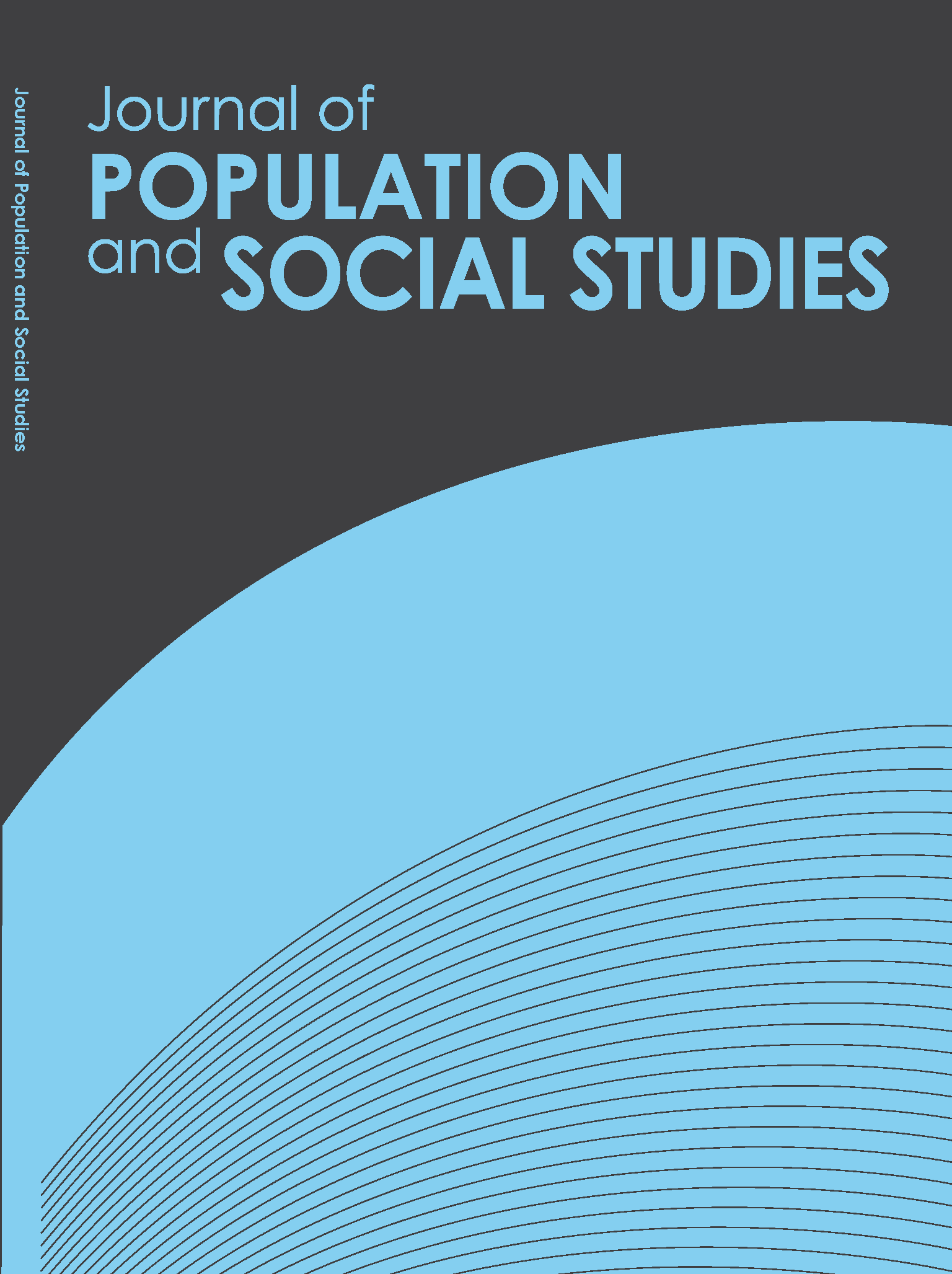Availability of Adult Children with Elderly Parents and Their Spatial Patterns: Evidence from a Rural District, Northeastern Thailand
Main Article Content
Abstract
Article Details
References
• Campbell, L. D., & Anne, M. (2003). The gendered nature of men's filial care. Journal of Gerontology: Social Sciences 58B(6), S350-S358.
• Chamratrithirong, A. (2007). Research on internal migration in Thailand: the state of knowledge. Journal of Population and Social Studies 16(1), 1-20.
• Chamratrithirong, A., Morgan, P., & Rindfuss, R. (1988). Living arrangements and family formation. Social Forces 66(4), 926-950.
• Curran, S., Garip F., Chung, C. Y., & Tangchonlatip, K. (2005). Gendered migrant social capital: evidence from Thailand. Social Forces 84(1), 225-255.
• Entwisle, B., Faust, K., Rindfuss, R., & Kaneda, T. (2007). Networks and contexts: variation in the structure of social ties. American Journal of Sociology 112(5), 1495-1533.
• Foster, B. L. (1975). Continuity and change in rural Thai family structure. Journal of Anthropological Research 31(1), 34-50.
• Hirschman, C. & Rindfuss, R. (1982). The sequence and timing of family formation events in asia. American Sociological Review 47(5), 660-680.
• Institute for Population and Social Research, Mahidol University. (2012). Mahidol population gazette. Nakhornpathom: Institute for Population and Social Research, Mahidol University.
• Institute for Population and Social Research, Mahidol University. (2006). Mahidol University population projections for Thailand, 2005-2025. Bangkok: Adison Press Product Limited.
• Jiang, L. & O'Neill, B. C. (2007). Impacts of demographic trends on US household size and structure. Population and Development Review 33(3), 567-591.
• Kamo, Y. & Zhou, M. (1994). Living arrangements of eldelry Chinese and Japanese in the United States. Journal of Marriage and Family 56(3), 544-558.
• Knodel, J., Kespichayawattana, J., Saengtienchai, C., & Wiwatwanich, S. (2010). How left behind are rural parents of migrant children? Evidence from Thailand. Ageing & Society, 30, 811-841.
• Knodel, J., & Chayovan, N. (1997). Persistence and Change in the Living Arrangements and Support of Thai Elderly Elderly in Asia Research Report Series. Ann Arbor: Population Studies Center, University of Michigan.
• Knodel, J., Chayovan, N., & Prachuabmoh, V. (2011). Impact of population change on well-being of elderly in Thailand. In G. Jones & W. Im-em (Eds.), Impact of Demographic Change in Thailand (pp. 35-63). Bangkok: United Nations Population Fund.
• Knodel, J., Chayovan, N., & Siriboon, S. (1992). The impact of fertility decline on familial support for the elderly: an illustration from Thailand. Population and Development Review, 18(1), 79-103.
• Knodel, J., & Saengtienchai, C. (1999). Studying living arrangements of the elderly: Lessons from a quasi-qualitative case study approach in Thailand. Journal of Cross-Cultural Gerontology, 14, 197-220.
• Kramarow, E. A. (1995). The elderly who live alone in the United States: historical perspectives on household change. Demography, 32(3), 335-352.
• Kulpravit, C. (2002). Health status and health problems of the Thai people. In S. Wibulpolprasert (Ed.), Thailand Health Profile 1999-2000. Nonthaburi: Bureau of Policy and Strategy, Ministry of Public Health.
• Lawton, M. P. & Brody, E. M.. (1969). Assessment of older people: self-maintaining and instrumental activities of daily living. Gerontologist, 9, 179-186.
• Limanonda, B. (1979). Mate selection and post nuptial residence in Thailand. Bangkok: Institute for Population Studies, Chulalongkorn University.
• Ogawa, N., & Retherford, R. D. (1993). Care of the elderly in Japan: changing norms and expectations. Journal of Marriage and Family, 55(3), 585-597.
• Podhisita, C. (1984). Marriage in rural northeast Thailand: a household perspective. In A. Chamratrithirong (Ed.), Perspectives on the Thai Marriage (pp. 71-112). Bangkok, Thailand: Sri Anata Press.
• Potter, S. H. (1979). Family life in a northern Thai village. Berkley and Los Angeles, California: University of California Press.
• Prasartkul, P., Vapattanawong, P., & Thongthai, V. (2011). Fertility transition and its impact. In G. Jones & W. Im-em (Eds.), Impact of Demographic Change in Thailand (pp. 17-33). Bangkok: United Nations Population Fund.
• Rindfuss, R. R., Jampaklay, A., Entwisle, B., Sawangdee, Y., Faust, K., & Prasartkul, P. (2004). The collection and analysis of social network data in Nang Rong, Thailand. In M. Morris (Ed.), Network Epidemiology A Handbook for Survey Design and Data Collection (pp. 175-200). New York: Oxford University Press.
• Rittirong, J. (2012). Kinship networks of the Thai elderly in a rural area: a case study of Nang Rong district, Buriram province (Doctoral dissertation). Mahidol University, Nakhornpathom.
• VanLandingham, M., & Hirschman, C. (2001). Population pressure and fertility in pre-transition Thailand. Population Studies-a Journal of Demography, 55(3), 233-248.
• Verdery, A. M., Entwisle, B., Faust, K., & Rindfuss, R. R. (2012). Social and spatial networks: kinship distance and dwelling unit proximity in rural Thailand. Social Networks, 34, 112-127.
• Weinstein, M., Sun, T.-H., Chang, M.-C., & Freedman, R. (1990). Household composition, extended kinship, and reproduction in Taiwan: 1965-1985. Population Studies, 44(2), 217-239.
• Yoddumnern-Attig, B., Richter, K., Soonthorndhada, A., Sethaput, C., & Pramualratana, A. (1992). Changing roles and statuses of women in Thailand: a documentary assessment. Nakhornpathom: Institute for Population and Social Research, Mahidol University at Salaya.


